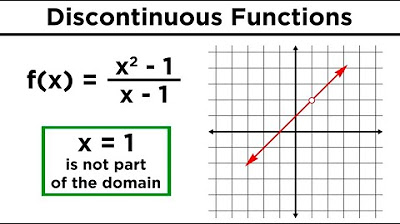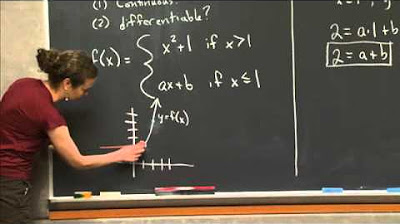Conditions for stokes theorem | Multivariable Calculus | Khan Academy
TLDRThis video script delves into the application of Stokes' Theorem, emphasizing the necessity of using piecewise-smooth surfaces and simple, closed boundaries for its validity. It explains that a surface must have continuous derivatives, meaning the slope changes gradually without jumps, allowing for the theorem's application. The script also clarifies the 'piecewise' aspect, demonstrating how non-smooth surfaces like a cup can be divided into smooth segments. Additionally, it discusses the importance of the boundary being simple, closed, and piecewise-smooth, using visual examples to illustrate the concepts, making complex calculus topics more accessible.
Takeaways
- 📘 Stokes' Theorem is applicable in a wide range of situations, but it requires specific types of surfaces and boundaries.
- 🔍 The surfaces must be 'piecewise-smooth,' meaning they can be divided into sections where derivatives are continuous.
- 📚 A 'smooth' surface in the context of calculus has continuous derivatives, which implies no abrupt changes in slope in any direction.
- 🧩 The term 'piecewise' allows for the use of Stokes' Theorem with surfaces that have edges or points of discontinuity, by breaking them into smooth segments.
- 🍵 An example given is a cup, which is not entirely smooth due to its edges but can be considered piecewise-smooth when divided into its bottom and sides.
- 🔄 The concept of 'piecewise' is crucial for applying Stokes' Theorem to more complex surfaces that are not entirely smooth.
- 🚫 The boundaries of the surfaces, when applying Stokes' Theorem, must be 'simple' and 'closed', meaning they do not cross or intersect themselves.
- 🔄 Similar to surfaces, boundaries must also be piecewise-smooth, allowing for division into sections with continuous derivatives.
- 🛤️ The script uses the analogy of a path or curve to illustrate the concept of a simple-closed boundary, which must loop back on itself without self-intersection.
- 📐 The importance of visualizing and understanding the continuity and smoothness of both surfaces and boundaries is emphasized for the application of Stokes' Theorem.
- 🤔 The script suggests that while it's challenging to imagine non-smooth surfaces, traditional calculus courses typically deal with piecewise-smooth surfaces that fit the theorem's criteria.
Q & A
What is Stokes' Theorem?
-Stokes' Theorem is a fundamental theorem in vector calculus that relates the surface integral of a vector field to a line integral of the curl of that vector field around the boundary of the surface.
What type of surfaces can be used with Stokes' Theorem?
-Stokes' Theorem can be applied to piecewise-smooth surfaces, which are surfaces that can be divided into pieces where each piece has continuous partial derivatives.
What does 'piecewise-smooth' mean in the context of surfaces?
-A piecewise-smooth surface is one that can be broken up into segments or pieces, each of which has continuous derivatives, meaning the slope or direction does not jump around abruptly within each piece.
Can Stokes' Theorem be used with surfaces that have edges or points of discontinuity?
-Yes, Stokes' Theorem can be used with such surfaces as long as they can be broken down into pieces that are smooth and have continuous derivatives within each piece.
What is the significance of the term 'smooth' in the context of the slope of a surface?
-In the context of a surface's slope, 'smooth' means that the slope changes gradually and does not have abrupt jumps or discontinuities when moving in any direction on the surface.
What are the requirements for the boundary of a surface when applying Stokes' Theorem?
-The boundary of a surface for Stokes' Theorem must be simple, closed, and piecewise-smooth. This means the boundary should not cross itself and should loop back on itself in a continuous manner.
What does a 'simple' boundary mean in the context of a surface's boundary?
-A simple boundary is one that does not cross or intersect itself. It forms a closed loop without any self-intersections.
How can a complex boundary be made suitable for Stokes' Theorem?
-A complex boundary can be made suitable for Stokes' Theorem by breaking it up into multiple simple boundaries that do not cross or intersect themselves.
What is the importance of a boundary being 'closed' in the context of Stokes' Theorem?
-A closed boundary is essential for Stokes' Theorem because it ensures that the boundary loops back on itself, creating a complete path that can be used for the line integral part of the theorem.
Can a path with abrupt changes in slope be considered piecewise-smooth?
-Yes, a path with abrupt changes in slope can be considered piecewise-smooth if it can be divided into sections where the slope changes gradually within each section, despite the discontinuities at the edges between sections.
How does one visualize a piecewise-smooth path or boundary?
-A piecewise-smooth path or boundary can be visualized as a series of smooth segments connected at points of discontinuity, where the direction or slope changes abruptly, but within each segment, the change is gradual.
Outlines
📚 Understanding Piecewise-Smooth Surfaces for Stokes' Theorem
This paragraph introduces the conditions for applying Stokes' Theorem, focusing on the requirement of piecewise-smooth surfaces. It explains that a smooth surface has continuous derivatives, meaning that the slope changes gradually in any direction without jumps. The 'piecewise' aspect allows for the inclusion of surfaces with edges, such as a cup, by breaking them down into smooth segments. The paragraph also emphasizes the importance of the boundary being simple and closed, which means it does not cross itself and loops back on itself, and also needs to be piecewise-smooth for the theorem to be applicable.
Mindmap
Keywords
💡Stokes' Theorem
💡Piecewise-smooth surfaces
💡Continuous derivatives
💡Boundary
💡Simple closed curve
💡Curl
💡Surface integral
💡Line integral
💡Slope
💡Fractally
💡Integrals
Highlights
Stokes' Theorem is applicable to a wide range of situations and is a general theorem.
The theorem requires the surface to be piecewise-smooth, meaning it has continuous derivatives in different directions.
A smooth surface is characterized by a gradual change in slope without any jumps.
The term 'piecewise' allows Stokes' Theorem to be used with surfaces that have edges or are not entirely smooth.
An example of a non-smooth surface is a cup, which has edges where the slope changes dramatically.
Piecewise-smooth surfaces can be broken down into smooth pieces for the application of Stokes' Theorem.
Most surfaces encountered in traditional calculus courses are piecewise-smooth and fit the theorem's criteria.
Visualizing non-smooth surfaces with fractal-like points can be challenging.
Stokes' Theorem also requires the boundary to be simple, meaning it does not cross or intersect itself.
A simple closed boundary is one that loops in on itself without any self-intersections.
The boundary must also be piecewise-smooth, allowing it to be divided into sections with continuous derivatives.
An example of a non-smooth path is one with edges where the slope changes abruptly.
In line integrals, non-smooth paths can be broken down into smooth segments for computation.
For Stokes' Theorem to be applicable, the surface must be piecewise-smooth and the boundary simple-closed and piecewise-smooth.
Understanding the conditions for applying Stokes' Theorem is crucial for successful application in various mathematical problems.
The theorem's generality allows it to be used in a wide array of mathematical and physical contexts.
The piecewise-smooth condition is key to extending the theorem's applicability to more complex surfaces.
The concept of a simple-closed boundary is fundamental to the theorem's application in evaluating surface integrals.
Transcripts
5.0 / 5 (0 votes)
Thanks for rating:





